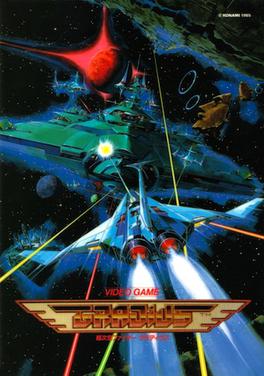
Gradius is a side-scrolling shooter video game developed and published by Konami. The first game in the Gradius series, it was originally released as a coin-operated arcade game in 1985. The player maneuvers a spacecraft known as the Vic Viper that must defend itself from the various alien enemies. The game uses a power-up system called the "power meter", based upon collecting capsules to purchase additional weapons.
A sports video game is a video game that simulates the practice of sports. Most sports have been recreated with video games, including team sports, track and field, extreme sports, and combat sports. Some games emphasize playing the sport, whilst others emphasize strategy and sport management. Some, such as Need for Speed, Arch Rivals and Punch-Out!!, satirize the sport for comic effect. This genre has been popular throughout the history of video games and is competitive, just like real-world sports. A number of game series feature the names and characteristics of real teams and players, and are updated annually to reflect real-world changes. The sports genre is one of the oldest genres in gaming history.

Track & Field, also known as Hyper Olympic in Japan and Europe, is a 1983 Olympic-themed sports video game developed by Konami for arcades. The Japanese release sported an official license for the 1984 Summer Olympics. In Europe, the game was initially released under the Japanese title Hyper Olympic in 1983, before re-releasing under the US title Track & Field in early 1984.

Xevious is a vertically scrolling shooter arcade video game developed and published by Namco in 1982. It was released in Japan by Namco and in North America by Atari, Inc. Controlling the Solvalou starship, the player attacks Xevious forces before they destroy all of mankind. The Solvalou has two weapons at its disposal: a zapper to destroy flying craft, and a blaster to bomb ground installations and enemies. It runs on the Namco Galaga arcade system.
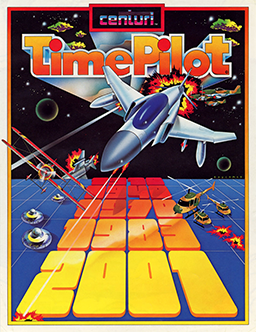
Time Pilot is a multidirectional shooter arcade video game designed by Yoshiki Okamoto and released by Konami in 1982. It was distributed in the United States by Centuri, and by Atari Ireland in Europe and the Middle East. While engaging in aerial combat, the player-controlled jet flies across open airspace that scrolls indefinitely in all directions. Each level is themed to a different time period. Home ports for the Atari 2600, MSX, and ColecoVision were released in 1983.
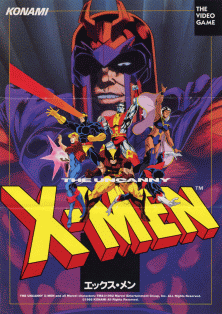
X-Men is a side-scrolling beat 'em up game produced and released by Konami for arcades in 1992, based on the Marvel Comics superhero team of the same name. The in-game character designs are based on the 1989 cartoon X-Men: Pryde of the X-Men. In the game, up to six players control the X-Men to defeat their archenemy Magneto. The six-player version of the game utilizes two screens housed in a deluxe cabinet. It was one of the top five highest-grossing dedicated arcade games of 1992 in the United States, while the Amusement & Music Operators Association (AMOA) nominated it for the "most innovative new technology" award.

Vulgus is a vertically scrolling shooter video game developed and published by Capcom in Japan in 1984 and released in North America by SNK the same year. The game was Capcom's first video game. The game is included in Capcom Classics Collection and is available as freeware.

Pole Position II is the sequel to racing simulation game Pole Position, released by Namco for arcades in 1983. As with its predecessor, Namco licensed this game to Atari, Inc. for US manufacture and distribution. Atari Corporation released a port as the pack-in game for its Atari 7800 ProSystem console launch in 1986. Pole Position arcade machines can be converted to Pole Position II by swapping several chips.
Gradius is a series of shooter video games, introduced in 1985, developed and published by Konami for a variety of portable, console and arcade platforms. In many games in the series, the player controls a ship known as the Vic Viper.

Seicross, known as Sector Zone in Japan, is a shooter arcade game developed and released by Nichibutsu in Japan and North America. Despite the original arcade game being titled Sector Zone, Nichibutsu later ported it to the Famicom as Seicross (セクロス). This port was also published in North America for the Nintendo Entertainment System by FCI.

Grobda is a 1984 multidirectional shooter arcade video game developed and published by Namco. It is a spin-off from Xevious, as the player's tank first appeared in that game as an enemy. It runs on Namco Super Pac-Man hardware but with a video system like that used in Mappy and The Tower of Druaga, and it also uses a DAC for the "Get Ready" speech sample at the start of each round.

Super Xevious is a vertically scrolling shooter released as an arcade video game in Japan in 1984. It was developed and published by Namco as an updated version of Xevious (1982) created as a response to the overwhelming success of the original in Japan. It was sold as conversion kit for existing Xevious cabinets.

Namco Classic Collection Vol. 1 is a 1995 arcade game compilation developed and published by Namco. It includes three of the company's most well-known games from the early 1980s — Galaga (1981), Xevious (1983), and Mappy (1983) — alongside brand-new "Arrangement" remakes of these games that have updated gameplay, visuals, and sounds. The arcade originals are also modified slightly to end after a certain number of rounds. Super Xevious (1984) is also playable. It ran on the Namco ND-1 arcade system, being one of the first games to utilize it.
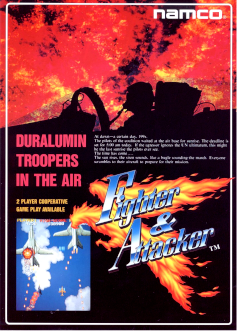
Fighter & Attacker is a 1992 vertical-scrolling shooter arcade game developed and published by Namco.

Badlands (バッドランズ) is a video game released and developed by Konami on the LaserDisc system in 1984 and published by both Konami and Centuri. It debuted at the Amusement and Music Operators Association (AMOA) Show in October 1983 and was later released to the public in early 1984. In addition to its LaserDisc version, two versions of a Badlands video game cabinet exist, one produced by Konami, and one by Centuri.

Cobra Command, known as Thunder Storm (サンダーストーム) in Japan, is an interactive movie shooter game originally released by Data East in 1984 as a LaserDisc-based arcade game. Released as an arcade conversion kit for Bega's Battle (1983), Cobra Command became one of the more successful laserdisc games in 1984. A Mega-CD port of Cobra Command developed by Wolf Team was released in 1992.

Tutankham is a 1982 arcade video game developed and released by Konami and released by Stern in North America. Named after the Egyptian pharaoh Tutankhamun, the game combines a maze shoot 'em up with light puzzle-solving elements. It debuted at the European ATE and IMA amusement shows in January 1982, before releasing worldwide in Summer 1982. The game was a critical and commercial success and was ported to home systems by Parker Brothers.
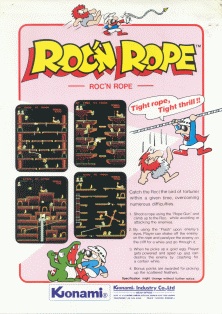
Roc'n Rope is a platform game released in arcades in 1983 by Konami, Kosuka, and Interlogic. It was designed by Tokuro Fujiwara. The player controls a flashlight and harpoon-gun equipped archaeologist who must ascend a series of rocky platforms to reach a phoenix bird.

Galactic Warriors (ギャラクティックウォーリアーズ) is a 1985 fighting arcade video game developed and published by Konami. It is Konami's second fighting game released after their 1985 arcade-hit Yie Ar Kung-Fu. It is also the first fighting game with multiple playable characters with different move sets, as well as the first mecha-based fighting game.
A vertically scrolling video game or vertical scroller is a video game in which the player views the field of play principally from a top-down perspective, while the background scrolls from the top of the screen to the bottom to create the illusion that the player character is moving in the game world.

















